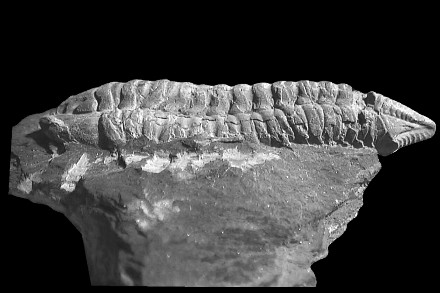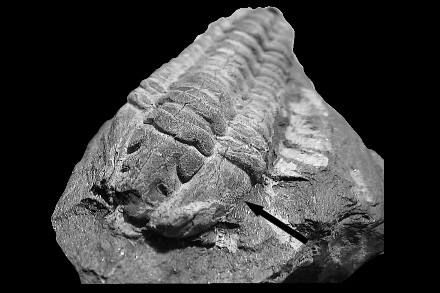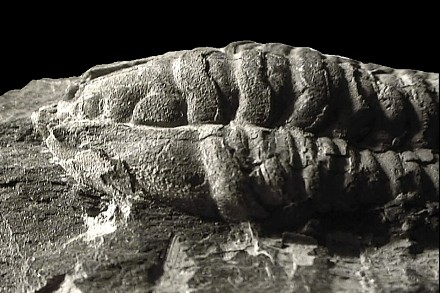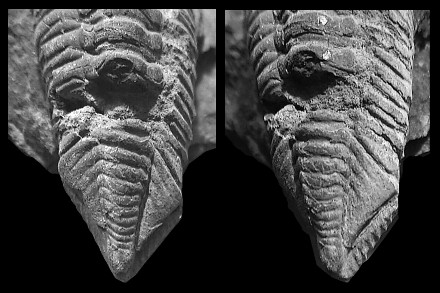

Specimen description :
-
Almost complete, prone on matrix
- Part of anterior border of the cephalon missing as of the last thoracic ring.
- Exoskeleton hardly granulous.
- Ordovician.
- Valongo, Portugal.
- Size : 72 mm.

Salterocoryphe salteri
An ordovican trilobite from Portugal. This specimen would have been "classical" if its granulation had more marked, thus having made it harder to identificate.
Salterocoryphe salteri can be found in W france and Iberian Peninsula, from Llanvirn to Llandeilo. It belongs to Salterocoryphe which includes the following species : Salterocoryphe salteri (ROUAULT 1851), Salterocoryphe sampelayoi HAMMAN 1977 of the Sierra Morena, Salterocoryphe n. sp. aff. sampelayoi HAMMAN 1977 found in "Alisedas" (Asturies) and Salterocoryphe lusitanica THADEU1949 in Iberian peninsula.
 |
 |
|
|
Specimen description :
|
 |
Diagnosis :
| Order
|
Phacopida
|
SALTER 1864
|
Occurrence: Lower Ordovician (Tremadoc) to Upper Devonian (Famennian).
|
| Suborder | Calymeninæ | SWINNERTON 1915 |
|
| Family
|
Calymenidæ
|
BURMEISTER 1843
|
|
| Subfamily |
Colpocoryphiinæ | HUPÉ 1855 |
|
| Genus |
Salterocoryphe |
HAMMANN 1977 |
|
| Species |
salteri |
(ROUAULT 1851)
|
|
Discussion :
Salterocoryphe and Colpocoryphe are two very close genera, mostly in their enrollment mode. But on a hylogenetical consideration, Salterocoryphe is closer to Nesereutus. Salterocoryphe differs from it with a shorter preglabellar area, plus courte, upward directed and convex, with a pygidium whose external portions of the pleurae show a clearer segmentation while Colpocoryphe presents a preglabellar area even shorter but directed downwards, with pleurae with smooth external portions. The glabella of Salterocoryphe generally presents an anterior tappering more marked associated with an external concavity more or less marked in its former portion than Colpocoryphe, whose anterior portion has an external convexity rather. It will be also noted that Colpocoryphe presents eyes located behind and on bulkier ocular stalks.
HENRY describes in 1980 in the Massif Armoricain Saltecoryphe
salteri salteri (ROUAULT) and Saltecoryphe salteri
subsp. indet. who presents an anterior glabelar border rounder, a larger
preglabellar area (long.) and higher occular stalks. RABANO
does not follow nevertheless this distinction considering the large morphological
variety of the glabella and of the preglabellar area among the collected specimens.
Saltecoryphe salteri is different mainly from S. lusitanica by the presence of granulations on the exoskeleton, by a glabella tapering forward, particularly from S2.
Lastly, it will be noted that Calymene transiens VERNEUIL & BARRANDE 1856 collected by these authors in the synclinal of Almadén is a synonym of Saltecoryphe salteri.
Complementary pictures :
 |
 |
|
|
Frontal oblique view of the cephalon. Arrow indicatig
the residual zone of the granulations.
|
Details of the granulations.
|
 |
|
Dorsal view of the cephalon. Glabella.
|
 |
 |
|
Lateral view of the pygidium.
|
References :
HAMMANN W. 1972. Neue Propare Trilobiten aus dem Ordovizium Spaniens. [New Proparian Trilobites from the Ordovician of Spain]. Senckenb. Lethaea, 53 (5) : pp 371 - 381. hb,
HAMMANN W. 1974. Phacopina und Cheirurina (Trilobita) aus dem Ordovizium von Spanien. Senckenb. Lethaea, 55 (1/5) : pp 1 - 151.
LEBRUN P. 2002. Trilobites de France. Tome I. Généralités sur les trilobites, Massif Armoricain (bretagne, Normandie, Vendée). Minéraux et Fossiles. Hors série N°14.
RABANO I. 1989. Trilobites del Ordovícico Medio del sector meridional de la zona Centroibérica española. Bol. geol. min. n° III, IV, V, VI. Vol. 100.